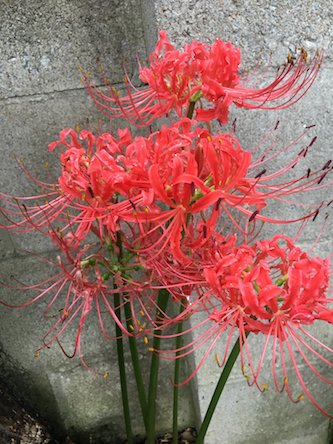The red spider lily, red magic lily, or equinox flower, is in the amaryllis family. It is originally from China, Korea, and Nepal. It flowers in late summer or autumn, often in response to heavy rainfall. The common name hurricane lily refers to this characteristic, as do other names, such as resurrection lily.
It is a bulbous perennial. It normally flowers before the leaves appear, on stems 12–28 inches tall. The leaves are narrow parallel-sided with a paler central stripe. The flowers are arranged in umbels. Individual flowers are irregular, with narrow segments curving backwards, and long projecting stamens.
Plants flower in late summer or early fall and leaves follow remaining through winter and disappearing in early summer. Flowers fade after a week from brilliant fluorescent red to a deep pink. Bulbs of are very poisonous and are used in Japan to surround rice paddies and houses to keep pests and mice away. In Japan the red spider lily signals the arrival of fall. Buddhists use it to celebrate the arrival of fall with a ceremony at the tomb of one of their ancestors. They are planted on graves to show tribute to the dead. People believe since the red spider lily is mostly associated with death, one should never give a bouquet of these flowers.
They were associated with Japanese Christian martyrs in medieval times. These scarlet flowers usually bloom near cemeteries around the autumnal equinox and are described in Chinese and Japanese translations of the Lotus Sutra as ominous flowers that guide the dead into the next reincarnation. Legends say that when you see someone that you may never meet again, these flowers would bloom along the path. Japanese people often used the flowers in funerals, hence the name flower of the afterlife.

